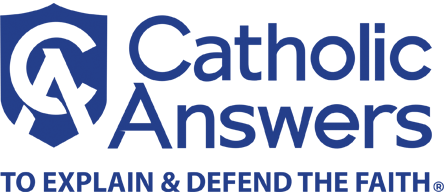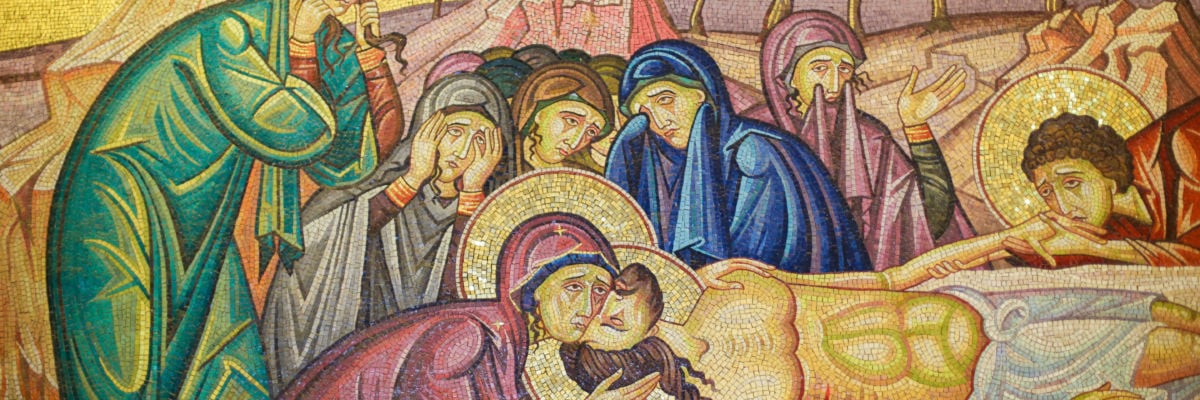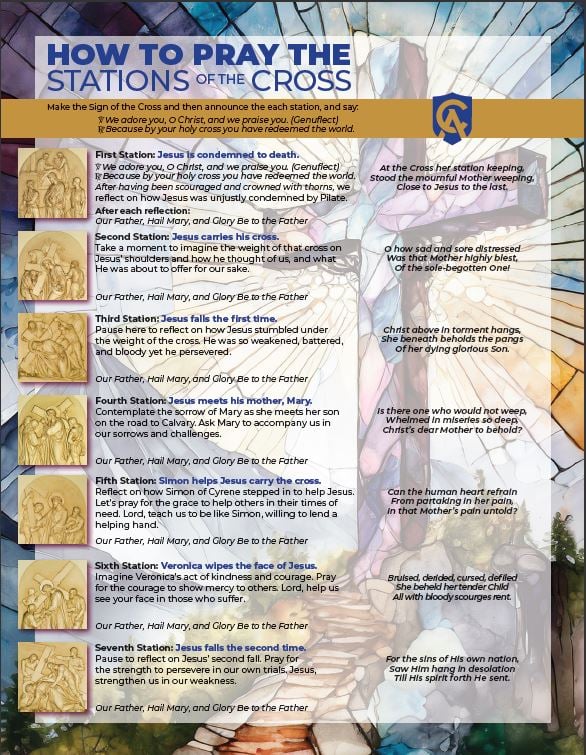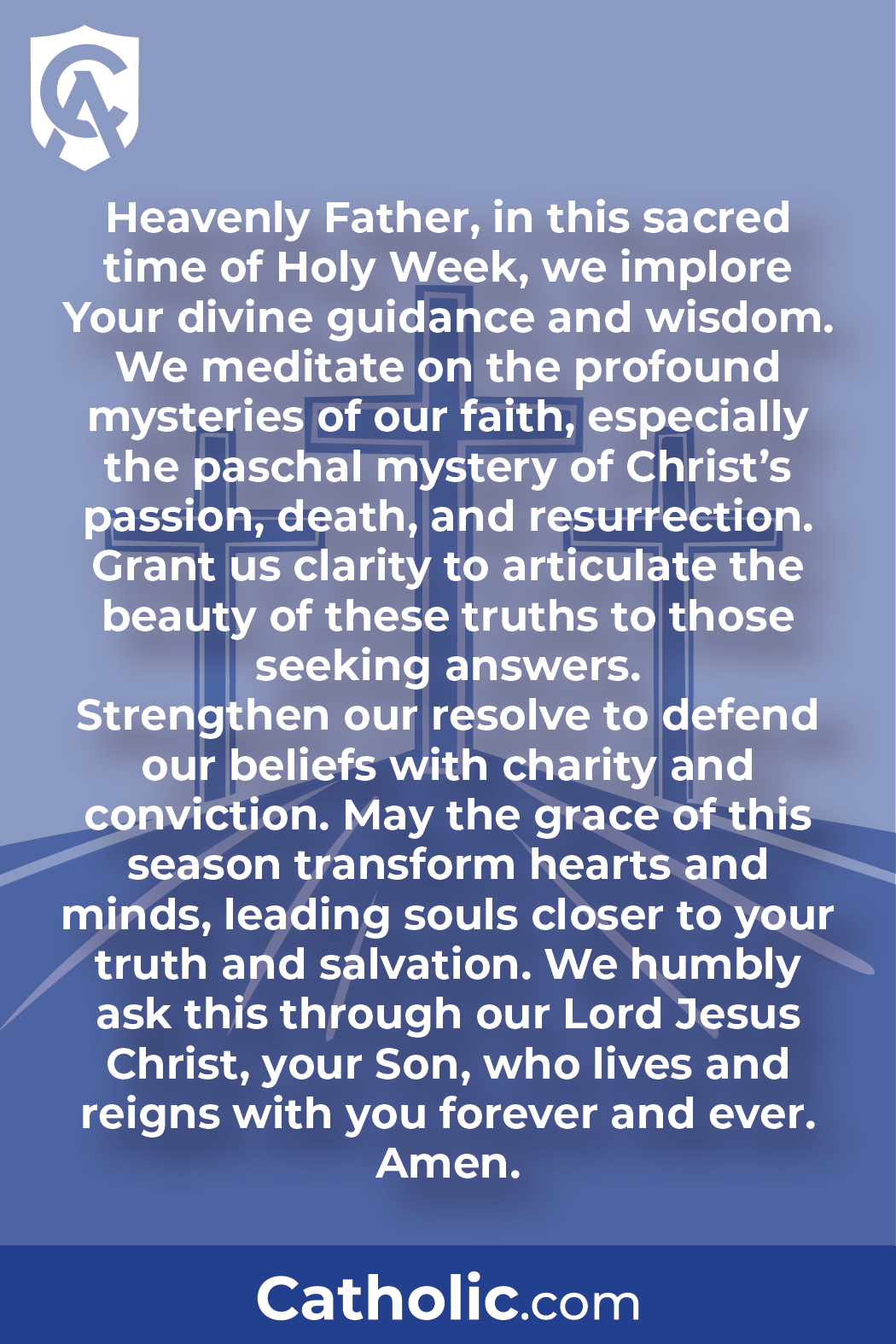
What is Holy Week?
Holy Week is the most sacred seven days each year in the Catholic Church. It encompasses the crescendo of Lent, the sorrow of Good Friday, and the joy of the Easter Vigil which commences the celebration of Easter Sunday. Holy Week begins with Palm Sunday, a day on which Jesus enters Jerusalem triumphantly astride a colt (Luke 19:28–40; Zech. 9:9), yet also anticipates his Passion and death because people can’t reconcile his being both the Messiah King and the Suffering Servant (Luke 18:31–34; 22:37; see Isa. 52:13—Isa. 53:12). There are many other rich traditions and key events during the week, from Jesus’s institution of the Eucharist at the Last Supper on Holy Thursday to the solemn events of Good Friday, including the Stations of the Cross. Learn all about the holiest week of the year in the Catholic Answers Guide to Holy Week.
What Is Palm Sunday?
Holy Week begins with Palm Sunday, a day that echoes with the elated cries of “Hosanna in the highest heaven!” (Matt. 21:9). Jesus enters Jerusalem, where crowds lay palm branches at his feet, recognizing him as the long-awaited Messiah. The symbolic act of laying down palm branches was a gesture of homage reserved for kings and dignitaries in ancient Israel, in this case acknowledging Jesus as the rightful King of Israel (Mark 11:1–11; Luke 19:28–40; John 12:12–19). As Jesus enters the holy city riding a donkey, the crowd is filled with anticipation, reverence, and jubilation.
What Is Holy Wednesday?
On Wednesday of Holy Week, Judas Iscariot, one of the twelve apostles, decides to betray Jesus, handing Christ over to the high priests and Temple guards:
So he agreed, and sought an opportunity to betray him to them in the absence of the multitude (Luke 22:6).
Since Judas was acting as their spy, this day has become known as “Spy Wednesday.” Some traditions consider it a day of preparation. A close study of the Gospels shows that the betrayal involves detailed and time-sensitive planning.
What Is Holy Thursday?
Holy Thursday, also known as Maundy Thursday, commemorates the Last Supper. On Holy Thursday, Jesus institutes the Eucharist and washes the feet of his apostles. This is captured in John 13:5, which depicts the humility, service, and love of Christ that we, his disciples, are called to emulate. In a culture where washing feet was a task relegated to servants, Jesus, the Son of God, takes on the role of a servant and thereby ordains His apostles as the first ministerial priests of the New Covenant (see Matt 20:25–28; 18:1–4).
When he had washed their feet, and taken his garments, and resumed his place, he said to them, “Do you know what I have done to you? You call me Teacher and Lord; and you are right, for so I am. If I then, your Lord and Teacher, have washed your feet, you also ought to wash one another’s feet. For I have given you an example, that you also should do as I have done to you” (John 13:12–15).
The Holy Thursday foot washing ceremony has deep religious significance: according to Tradition, it represents the service and charity of Christ, who came “not to be served, but to serve, and to give his life as a ransom for many” (Matt. 20:28).
The season of Lent ends on the evening of Holy Thursday, which commences the Easter Triduum or “Paschal Triduum,” a three-day period named after Jesus’s offering Himself as the New Covenant Passover Lamb of God, and which concludes with Evening Prayer (Vespers) on Easter Sunday.
What Is Good Friday?
Good Friday, the most solemn day of Holy Week, commemorates the Passion of Jesus Christ. It is a day of reflection, penance, and deep contemplation on the ultimate sacrifice made for the redemption of humanity. Christ’s Passion, culminating in his crucifixion and death, reminds us of the weight of our sin and the unfathomable love of God. Catholics around the world participate in solemn liturgies, reflecting on our Lord’s redemptive suffering, venerating the Cross, and receiving Holy Communion. They also pray the Stations of the Cross, in which the faithful meditate on our Lord’s journey to Calvary, a place also called “Golgotha,” meaning “skull.”
What Are the Stations of the Cross?
The Stations of the Cross are 14 stations that walk through the Passion of Jesus Christ. The stations of the cross, also called the Way of the Cross, or Via Crucis, showcase Christ’s journey from condemnation, to crucifixion, and burial. It’s a devotion that dates back to the 4th century, when pilgrims journeyed to Jerusalem to walk the path of Christ’s passion, called the Via Dolorosa. It’s typically prayed during Lent, especially on Fridays and Good Friday, the devotion consists of 14 stations, each marking a specific event from Christ’s final hours. Many parishes have these stations displayed visually along the walls year round, inviting the faithful to meditate on Christ’s suffering and sacrifice for humanity.
Free Download | Stations of the Cross Prayer Guide
The Catholic Church observes the “Adoration of the Cross” during the Good Friday Celebration of the Passion of the Lord. In this ritual, the faithful approach the cross, often adorned with flowers, and venerate it with reverent gestures, such as kissing or genuflecting. It is a powerful ritual that encapsulates the deep sorrow of the day while acknowledging the transformative power of Christ’s sacrifice.
Finally, there is also reception of Holy Communion without the Sacrifice of the Mass, because Good Friday commemorates the day Our Lord offered Himself on behalf of us (Matt. 26:26–28).
What Is the Easter Vigil?
Holy Saturday is a day of vigil, a period of waiting and anticipation. The Easter Vigil, the summit of the Paschal Triduum on Holy Saturday evening, is a profound liturgical celebration that takes place after nightfall. This ancient tradition, dating back to the fourth century, marks the high point of the Triduum and thus ignites the celebration of our Lord’s Resurrection from the dead. At the Easter Vigil Mass, the Paschal—or Easter—Proclamation is made, which is part of the ceremony to light the paschal candle.
Traditionally, the Easter Vigil is the Mass where catechumens are baptized, confirmed, and receive their First Holy Communion, and candidates are confirmed and receive the Eucharist for the first time, if they have not already.
Known in Latin as “The Exsultet,” the Proclamation and the Easter Vigil’s baptismal liturgy symbolize together our journey from darkness to light and death to new life in Christ.
What Is the Sacred Triduum?
The Sacred Triduum begins with the Evening Mass of the Lord’s Supper on Holy Thursday, continues through Good Friday with the Celebration of the Passion of the Lord, reaches its summit with the Easter Vigil, and concludes with Vespers of Easter Sunday. It stands as the sacred triad culminating with the joyous celebration of Easter, encapsulating the great mystery of Christ’s passion, death, and resurrection.
Free Download | Holy Week Prayer Card
Holy Week Schedule 2026 | Find a Church Near You
Here’s a schedule of Holy Week 2026:
- March 29: Palm Sunday of the Passion of the Lord
- March 30 & 31: Monday and Tuesday of Holy Week
- April 1: Holy Wednesday or Spy Wednesday
- April 2: Holy Thursday: Evening Mass of the Lord’s Supper
- April 3: Good Friday: The Celebration of the Passion of the Lord
- April 4/April 5: Holy Saturday and Easter Vigil—Celebration of Easter Sunday of the Lord’s Resurrection Commences
- April 5: Easter Sunday of the Resurrection of the Lord
Related Content
Articles
Q & As
Books
Podcasts
- Holy Week Through The Eyes of the Apostles
- What Happened on Holy Thursday? The Last Supper and the Priesthood




